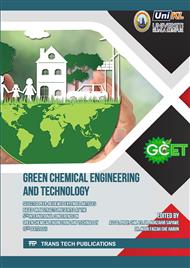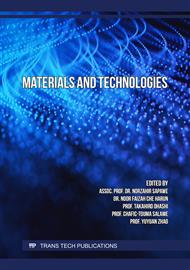[1]
Bepi.mpob.gov.my. MALAYSIA PRICES OF CRUDE PALM OIL. (online) Available at: http://bepi.mpob.gov.my/admin2/price_local_daily_view_cpo_msia.php?more=Y&jenis=1Y&tahun=2019 (2020).
Google Scholar
[2]
C. Yap, K. Soh, M. Chong, Y. Chan, V. Christina, Palm oil potential: the problem of methane emissions at Malaysia's palm oil mills can be turned on its head - if the industry buys into biogas. Chem Eng, 910 (2017) 42-45.
Google Scholar
[3]
V. Sethu, A. Selvarajoo C.W. Lee, G. Pavitren, S.L. Goh, X.Y. Mok, Opuntia cactus as a novel bio-coagulant for the treatment of palm oil mill effluent, ProgEE, 9 (2019) 11-26. http://www.akademiabaru.com/doc/progeeV9_N1_P11_26.pdf.
Google Scholar
[4]
S Bhatia, Z. Othman, A. Ahmad, A, Pretreatment of palm oil mill effluent (POME) using Moringa oleifera seeds as natural coagulant. J. Hazard. Mater., 145(1-2) (2007) 120-126. doi: https://doi.org/10.1016/j.jhazmat.2006.11.003.
DOI: 10.1016/j.jhazmat.2006.11.003
Google Scholar
[5]
N. Saifuddin N, S. Dinara S. Pretreatment of palm oil mill effluent (POME) using magnetic chitosan. J. Chem., 8 (s1) (2011) 67–78.
DOI: 10.1155/2011/427532
Google Scholar
[6]
C. Chung, A. Selvarajoo, V. Sethu, A. Koyande, A. Arputhan, A. Z. Lim, Treatment of palm oil mill effluent (POME) by coagulation flocculation process using peanut–okra and wheat germ–okra. Clean Technol Environ Policy, 20 (9) (2018) 1951-1970. doi: https://doi.org/10.1007/s10098-018-1619-y.
DOI: 10.1007/s10098-018-1619-y
Google Scholar
[7]
B.C. Choong, A. Peter, K.Q. Chong, P. Ragu, V. Sethu, A. Selvarajoo, A. S.K. Arumugasamy, Treatment of palm oil mill effluent (POME) using chickpea (Cicer arietinum) as a natural coagulant and flocculant: Evaluation, process optimization and characterization of chickpea powder, J. Environ. Chem. Eng., 6 (5) (2018) 6244. doi: https://doi.org/10.1016/j.jece.2018.09.038.
DOI: 10.1016/j.jece.2018.09.038
Google Scholar
[8]
J.W. Yong, S.K. Arumugasamy, H.C. Chang, A. Selvarajoo, V. Sethu, Comparative study of artificial neural network (ANN), adaptive neuro-fuzzy inference system (ANFIS) and multiple linear regression (MLR) for modeling of Cu (II) adsorption from aqueous solution using biochar derived from rambutan (Nephelium lappaceum) peel, Environ. Monit. Assess., 192 (2020) 239.
DOI: 10.1007/s10661-020-08268-4
Google Scholar
[9]
M.N.N. Asyikin, V. Sethu, S.K Arumugasamy, A. Selvarajoo, Artificial Neural Network (ANN) modelling of Palm Oil Mill Effluent (POME) treatment with natural bio-coagulants, Environ. Process., 7 (2) (2020) 509-535.
DOI: 10.1007/s40710-020-00431-w
Google Scholar
[10]
C. Dennis, C., J. Jewaratnam, J. Chia, Fenugreek Seeds Coagulant and Banana Peels Flocculant for the Treatment of Palm Oil Mill Effluent, RCEST, 1, (2018) 18. http://www.asianscientificresearch.com/journals/index.php/RCEST/article/view/18.
Google Scholar
[11]
V. Sethu, A. Mendis, R. Rajiv, S. Chimbayo, S. Vejayan, Fenugreek seeds for the treatment of Palm Oil Mill Effluent (POME), Int. J. Chem. Eng, 6 (2) (2015) 126.
Google Scholar
[12]
N. Yéwêgnon, S. Philippe, A. Abdoukarim, Y. Abdou, K. Alassane, D.C.P. Agbangnan, M. Daouda, S. Koko, C. Dominique, Evaluation of Aloe vera gel leaf gel as a natural flocculant: Phytochemical screening and turbidity removal trials of water by coagulation flocculation. Res. J. Recent Sci., 4 (12) (2016) 1-6.
Google Scholar
[13]
A. Setiawan, D. Puspitasar, T.U. Dewi, R.T. Azis E. Julianto, Use of Aloe vera gel and Moringa Oleifera as Biocoagulant in Palm Oil Industry., Test Eng. Manag. 82 (2020) 3435-3439.
Google Scholar
[14]
E.L. Maldonado, M.O. Guzman, J.J. Baizaval, A.O. Terán, Coagulation–flocculation mechanisms in wastewater treatment plants through zeta potential measurements. J. Hazard. Mater., 279 (2014) 1-10.
DOI: 10.1016/j.jhazmat.2014.06.025
Google Scholar
[15]
R. Singh, Membrane Technology and Engineering for Water Purification. 2nd ed. (2015) 369-425.
Google Scholar
[16]
R. Haouala, S. Hawala, A. El-Ayeb, R. Khanfir, N. Boughanmi, Aqueous and organic extracts of Trigonella foenum-graecum L. inhibit the mycelia growth of fungi. J. Environ. Sci., 20(12) (2008) 1453-1457.
DOI: 10.1016/s1001-0742(08)62548-6
Google Scholar
[17]
M. Czemierska, A. Szczes, A. Wilkolazka, Purification of wastewater by natural flocculants. BioTechnologia-Journal of Biotechnology, Computational Biology and Bionanotechnology, 4 (2015) 272-278. doi: https://doi.org/10.5114/bta.2015.57731.
DOI: 10.5114/bta.2015.57731
Google Scholar
[18]
S. Rahman, P. Carter, N. Bhattarai, Aloe vera gel for Tissue Engineering Applications. J. Funct. Biomater., 8 (1) (2017) 6.
Google Scholar
[19]
A. Helmenstine,. What You Need Know About Zeta Potential. (online) ThoughtCo. (2019) Available at: https://www.thoughtco.com/definition-of-zeta-potential-605810 (Accessed 23 April 2020).
Google Scholar
[20]
M. Abood, N. Azhari, A. Abdelmoneim, The use of peanut and sesame seeds as natural coagulant in the water treatment, IUKLRJ, 5 (1) (2017) 6.
Google Scholar



